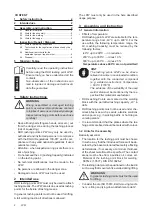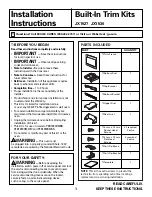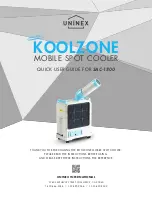
2
LPW
Carefully read the operating instructions
before using the RUD lashing point LPW.
Ensure that you have understood all the
contents.
Non-observation of the instructions can
lead to injuries or damage and will invali-
date the guarantee.
1 Safety instructions
WARNING
Wrong assembled or damaged lashing
points as well as impropriate use can lead
to injuries of persons and property damage.
Inspect all lashing points before each use
carefully!
•
Keep all body parts (fingers, hands, arms etc.) out
from the danger zone during the lashing process
(risk of squeezing).
• RUD lashing points LPW may only be used by
authorised and instructed persons in compliance
with the DGUV Regulations 109-017 and in com-
pliance with any valid national regulations if used
outside Germany.
• Attention - when suspension ring pivots there is a
risk of pinching.
• Do not exceed the LC (Lashing Capacity) indicated
on the lashing point.
•
No technical modifications must be made to the
LPW.
• No persons are allowed in the danger zone.
• Damaged or worn LPW must not be used.
2 Intended use
RUD lashing points LPW must only be used to attach
lashing means. The LPW can also be used as lashing
points for the fixture of lashing means.
In general, lashing points must not be used for lifting.
A full working load in all directions is allowed.
The LPW must only be used in the here described
usage purpose.
3 Assembly- and instruction
3.1 General information
•
Effects of temperature:
RUD lashing points LPW are suitable for the tem-
perature range from -40°C up to 400°C. For the
use within the following temperature range, the
LC (Lashing Capacity) must be reduced by the
following factors:
-40°C up to 200°C → no reduction
200°C up to 300°C → minus 10 %
300°C up to 400°C → minus 25 %
Temperatures above 400°C are not permitted!
HINT
The lashing points LPW can be stress-
relieved one-time in an unloaded condition,
together with the connected component
(e.g. welded construction): Temperature
< 600°C (1100°F)
The evidence of the suitability of the used
weld metal must be mentioned by the res-
pective filler material manufacturer.
• RUD-Lashing Points are marked at the welding
block with the permitted lashing capacity „LC“ in
daN.
• RUD lashing points must not be used under che-
mical influences such as acids, alkaline solutions
and vapours e.g. in pickling baths or hot dip gal-
vanising plants.
• It is recommended, that the places where the las-
hing points are fixed should be marked with colour.
3.2 Hints for the assembly
Basically essential:
• The location for the lashing point must be chosen
in such a way that the introduced forces will be ab-
sorbed by the base material without safety affecting
deformations, if necessary a minimium thickness
of the sheet metall must be specified. The contact
areas must be free from inpurities, oil, colour, ect.
Material of the lashing point block for welding:
S355J2 (1.0577), DIN EN 10025-2
• The lashing points must be positioned on the load in
such a way that movement is avoided during lifting.
WARNUNG
In general, lashing points must not be used
for lifting.
• Consider the die ISO 15818 „Earth-moving machi-
nery - Lifting and tying-down attachment points“.
CONTENT
1 Safety instructions
2
2 Intended use
2
3 Assembly- and instruction
2
3.1 General information ..................................................2
3.2 Hints for the assembly ..............................................2
3.3 Hints for the welding .................................................3
3.4 Hints for the usage ...................................................3
4 Inspection / Repair / Disposal
4
4.1 Hints for periodical inspections .................................4
4.2 Test criteria for the regular visual inspection by the
user ...........................................................................4
4.3 Additional test criteria for the
competent person / repair worker .............................4
4.4 Disposal ....................................................................4
5 Tabellen / Tables
4
ENGLISH























